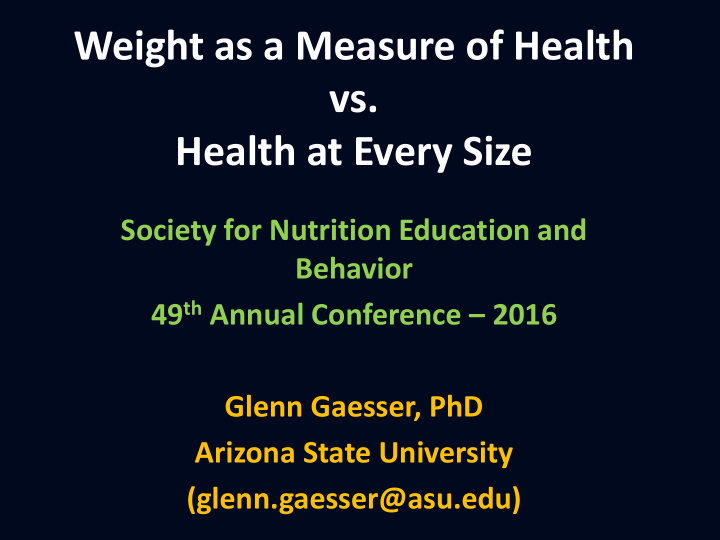



Weight as a Measure of Health vs. Health at Every Size Society for Nutrition Education and Behavior 49 th Annual Conference – 2016 Glenn Gaesser, PhD Arizona State University (glenn.gaesser@asu.edu)
Non-weight-loss-centered approach to treating “obesity-related” health conditions
Two Billion Reasons for a New Perspective on Obesity Prevention and Treatment
THE SCIENCE OF FAT After ‘The Biggest Loser,’ Their Bodies Fought to Regain Weight Contestants lost hundreds of pounds during Season 8, but gained them back. A study of their struggles helps explain why so many people fail to keep off the weight they lose. By GINA KOLATA MAY 2, 2016 Obesity , 2016
Weight, fat-free mass, and fat mass changes after 30 weeks of Biggest Loser competition and 6 years later
Changes in RMR and Metabolic Adaptation after 30 weeks of Biggest Loser competition and 6 years later
American Journal of Public Health , July 16, 2015 (online) • United Kingdom’s Clinical Practice Research Datalink from 2004 to 2014 • 76,704 obese men and 99,791 obese women • 9 years of follow-up
Results • 1283 men and 2245 women attained normal body weight • Annual probability of attaining normal weight: • 1 in 210 for men; 1 in 124 for women, • 1 in 1290 for men and 1 in 677 for women with BMI 40.0–44.9 • Annual probability of achieving a 5% weight reduction was 1 in 8 for men and 1 in 7 for women with BMI 40.0-44.9
Two Billion Reasons for a New Perspective on Obesity Prevention and Treatment
Obesity Prevalence by State, 1985 - 2010
Prevalence of Weight Loss Attempts 1980’s – 2000’s Yaesmiri et al, Int J Obes 2011; Bish et al, Obes Res 2005; Serdula et al, JAMA 1999; Serdula et al, Am J Publ Health 1994
Cumulative Weight-Loss Attempts by U.S. Adults, 1980 - present • ~ 2 Billion weight-loss attempts • ~ 7 weight loss attempts for every U.S. adult during the past thirty years
Paleo Med editerra rranean an D Diet iet Protein Power Su Sugar gar Buste sters! s! Dr. Atkin’s New Diet Pritikin Revolution Glu Glute ten-Free Ornish The South Beach Diet Dr. Phil’s Ultimate Weight Solution Enter the Zone
Prevalence of Desire to Weigh Less National Health and Nutrition Examination Surveys 2003-2008 Yaemsiri et al, Int J Obes 2011;35:1063-1070
Prevalence of Trying to Lose Weight Among BMI Categories BRFSS 2000 Bish et al. Obes Res 2005; 13:596-607
Most obese persons will not stay in treatment for obesity. Of those who stay in treatment, most will not lose weight and of those who do lose weight, most will regain it. --Albert Stunkard, 1958
Nurses’ Health Study II: 1989 -1993 Binge Eating and Weight Control Practices by Weight Cycling Status Field et al. Int J Obes 2004; 28: 1134-1142
Published Risks Associated With Weight Cycling: • Higher mortality rates • Cardiovascular Disease • Metabolic Syndrome/Diabetes • Hypertension • Higher HbA1c • Hyperinsulinemia • Dyslipidemias; lower HDL • Decreased resting and endothelium-dependent myocardial blood flow • Decreased adiponectin • Inflammation (elevation in CRP) • Gall bladder disease; cholecystectomy
Published Risks Associated With Weight Cycling: • Endometrial cancer • Renal Cancer • Colorectal cancer • Lymphohematopoietic cancers • Decreased Natural killer cell activity (compromised immune function) • Poor physical function • Attenuated improvements in health markers with weight loss • Android fat pattern • Decreased BMD • Forearm fractures • Hip fractures • Decreased telomere length • Loss of lean body mass
BMI and Mortality Typically a U- or J-Shaped Relationship Weight cycling? Use of weight-loss medications? Relative Risk Low fitness? 20 25 30 35 BMI
Current Sports Medicine Reports, 2015
Association of BMI and all-cause mortality in U.S. adults [from Flegal et al, JAMA 2013]
Association of cardiorespiratory fitness, BMI, and all- cause mortality in U.S. adults [from Barry et al, Prog Cardiovasc Dis, 2014 ]
Social & Personality Psychology Compass , 2013
Change in systolic and diastolic blood pressure by amount of weight loss maintained
Change in blood glucose by amount of weight loss maintained
Change in cholesterol and triglycerides by amount of weight loss maintained
Non-weight-loss-centered approach to treating “obesity-related” health conditions
BRFSS 2000 Prevalence of Dieting and Physical Activity Among Those Trying to Lose Weight Bish et al. Obes Res 2005; 13:596-607
Recommend
More recommend